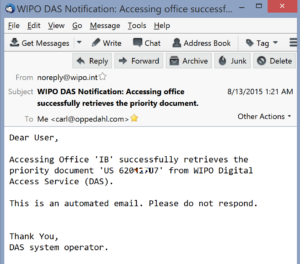There’s a nice new feature in ePCT. It used to be that if you were to file a new PCT application in RO/IB, and if you were to say that you plan to pay by means of a credit card, that what would happen is later (some days later) you would receive an email message with a link to a web page inviting you to pay the fees.
Now the ePCT system takes care of everything all at once. When you click “submit” to e-file the PCT application, and when you say you would like to pay the fee by credit card, then a new screen appears that permits you to type in the credit card number and other information. You can finish the e-filing session with the knowledge that you have indeed taken care of the fee payment.
This is good for several reasons.
First, it saves you having to docket to check for the arrival of the several-days-later email to pay the fee. (We estimate that every time we have to set and clear a docket, we incur an internal cost of something like $50.)
Second, it gets the fees into the RO’s hands sooner. Which means that the search fee gets into the hands of the ISA sooner. Which means the International Search Report and Written Opinion arrive sooner.
 in WIPO’s Digital Access Service (DAS). The feature has been there for some time but yesterday was the first time I actually saw it work. The feature is that you can set up a sort of “tripwire” and when some Office retrieves a certified copy of one of your priority applications from DAS, you will receive an email message letting you know that this happened. Yesterday for the first time I received such an email.
in WIPO’s Digital Access Service (DAS). The feature has been there for some time but yesterday was the first time I actually saw it work. The feature is that you can set up a sort of “tripwire” and when some Office retrieves a certified copy of one of your priority applications from DAS, you will receive an email message letting you know that this happened. Yesterday for the first time I received such an email.
